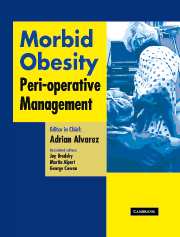Book contents
- Frontmatter
- Contents
- Contributors
- Foreword
- Preface
- Acknowledgments
- Dedication
- Section 1 General aspects
- Section 2 Pathophysiology
- Section 3 Pre-operative management
- Section 4 Peri-operative management of co-morbidities
- Section 5 Pharmacology
- Section 6 Monitoring
- Section 7 Intra-operative management
- 20 Positioning the morbidly obese patient for surgery
- 21 Airway management
- 22 Inhalational anesthesia
- 23 Total intravenous anesthesia
- 24 Anesthetic management for the obese parturient
- Section 8 Post-operative care
- Section 9 Conclusions
- Afterword
- Index
23 - Total intravenous anesthesia
from Section 7 - Intra-operative management
Published online by Cambridge University Press: 17 August 2009
- Frontmatter
- Contents
- Contributors
- Foreword
- Preface
- Acknowledgments
- Dedication
- Section 1 General aspects
- Section 2 Pathophysiology
- Section 3 Pre-operative management
- Section 4 Peri-operative management of co-morbidities
- Section 5 Pharmacology
- Section 6 Monitoring
- Section 7 Intra-operative management
- 20 Positioning the morbidly obese patient for surgery
- 21 Airway management
- 22 Inhalational anesthesia
- 23 Total intravenous anesthesia
- 24 Anesthetic management for the obese parturient
- Section 8 Post-operative care
- Section 9 Conclusions
- Afterword
- Index
Summary
Introduction: anesthetic planning, selection of the anesthetic technique (Why total intravenous anesthesia for the morbidly obese?)
As in every surgical—anesthetic practice, anesthesia for the morbidly obese has to be based upon pathophysiological patient's condition. After knowing how morbidly obese body behaves (and according to this; considering the most frequent risks) anesthetic targets have to be defined. Finally in order to get the best approach to those targets, technique and tactic could be reasonably planned. So the logical line of thoughts should be chronologically developed as follows:
Pathophysiological considerations.
Frequent risks and complications.
Anesthetic targets.
Anesthetic planning.
Pathophysiological considerations and frequent risks have been already considered in other chapters (see Chapters 2, 4, 5 and 8). Anyway, it should be remembered that the most frequent and prominent risks are:
gastric aspiration;
difficult mask ventilation and tracheal intubation;
rapid development of hypoxemia after apnea;
pulmonary atelectasis;
hemodynamic instability;
reduced capability to face stress situations (increments of stress hormones could develop hyperglycemia, hypertension, cardiac failure, arrhythmias and myocardial ischemia);
delay in recovery;
post-operative respiratory dysfunction;
deep venous thrombosis.
Accordingly basic anesthetic targets should be:
smooth and quick induction;
rapid and secure airway control;
prominent hemodynamic stability;
high versatility to manage changing levels of surgical stimuli to avoid increments in catecholamine activity;
fast and successful recovery, and ambulating capacity.
- Type
- Chapter
- Information
- Morbid ObesityPeri-Operative Management, pp. 305 - 324Publisher: Cambridge University PressPrint publication year: 2004

